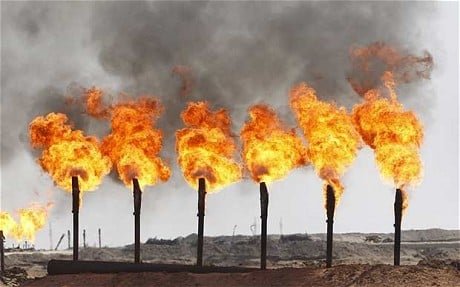by William Engdahl, …and New Eastern Outlook, Moscow
– with the Institute of Oriental Studies of the Russian Academy of Sciences, a research institution for the study of the countries and cultures of Asia and North Africa.
[ Editor’s Note: The boom and bust, pump and dump days of the shale oil and gas boom are upon us. All of this was predictable, as we had a metaphorical aligning of the planets to set it off in the first place.
For instance, prices were high in the beginning, at $74+ per barrel for oil, and loan money was cheap, almost down to zero, so the rush to jump in was predictable. VT was publishing years ago that those first in would buy the best plots where extraction was less costly.
It did not take a genius to see that that was a transitory boom stage. Shale deposits tend to deplete faster, sometimes in just a few years. New drilling was able to keep pace with the depleting wells, but as prices dropped due to the world oversupply, investors are running shy of that market now.
We also have the continual discovery of more oil and gas around the world, and the continuing long march to pipeline distribution in the Eurasian continent, where there are vast regions of undiscovered resources, aside from the well known ones in the Russian Arctic.
Bill Engdahl has worked the energy markets for many years and has a good overview piece for us. It has a “bullet in the head” ending, with news that where in the past with shale oil slowdowns, equipment was parked to use again when prices went up, this time it is being cannibalized for parts, or sold for scrap.
Is there a better indication that the US’ affair with shale oil and gas has run is course? That won’t stop Trump from touting how wonderful it all is, as he is betting the farm that a good economy will ride him to a second term, despite his legal and impeachment problems… Jim W. Dean ]
 Jim's Editor’s Notes are solely crowdfunded via PayPal
Jim's Editor’s Notes are solely crowdfunded via PayPal
Jim's work includes research, field trips, Heritage TV Legacy archiving & more. Thanks for helping. Click to donate >>

– First published ... November 06, 2019 –
In recent remarks to a Pennsylvania shale oil producers’ convention, US President Donald Trump, noting the spectacular growth in shale gas as well as shale oil over the past decade, remarked that unconventional shale energy had made “America the greatest energy superpower in the history of the world.”
On first look the achievement has indeed been impressive. Since 2011 the USA surpassed Russia to become the world’s largest producer of natural gas. By 2018 USA had passed Russia and Saudi Arabia to become the world leading oil producer. It is all because of US unconventional shale oil and gas. But the success may be short-lived.
The rise of shale energy and the favorable geological conditions in West Texas, North Dakota and elsewhere have given the US a clear geopolitical lever in world politics, not only in the Middle East or Venezuela policies. Also in the EU, where Russian gas remains the major supplier. Can the US continue to base policy on its leading role in gas and oil, or is this merely a blip due to end as suddenly as it appeared?
Just as a triumphant Trump was speaking in Pittsburg to the shale industry, Russian Energy Minister Novak pointed to recent slowing of shale oil output growth in key areas of the USA: “In the near future, if forecasts turn out correct, we will see a plateau in production.”
He pointed to the significant reduction in shale oil drilling in recent months and predictions by Wall Street of a significant slowing of oil increases from shale in 2020. Prospects for US shale gas are far from positive as well, despite a current supply glut domestically.
The LNG gas export terminal infrastructure, while it is increasing, is far from adequate to make the US a major supplier to the EU in competition to Russian gas. And money from Wall Street is drying up as well.
EU Defeat for Trump
The Trump Administration has staked much political effort on trying to convince the EU and other parts of the world to buy US shale gas instead of Russian conventional natural gas, arguing diversity of supply. That now looks unlikely to happen.
Despite strong US pressure to cancel Europe’s NordStream2 gas pipeline from Russia across the Baltic Sea to Germany, which will double capacity and reduce Ukraine pipeline dependency significantly, the last EU barrier, Denmark, just announced it would approve the Gazprom route through its waters.
The Danish decision, following months of Washington pressure, is a clear defeat for the Trump energy geopolitics strategy of substituting US shale gas as liquefied LNG for the Russian pipeline gas. Gazprom projects completion of the second line of the NordStream, doubling capacity, with gas deliveries to begin by early 2020.
As recently as July 2018 at a meeting with EU Commission President Juncker in Washington, Trump had announced that the European Union (EU) would soon be a “massive buyer” of US liquefied natural gas (LNG). That is yet to happen, though exports are up from a minimum level two years ago. US failure to block Russian gas deals a major blow to those hopes.
Aside from limited contracts between US LNG suppliers and Poland to date, there are few prospects now with EU approval of NordStream2 for major US LNG exports to EU markets in the next years.
Poland Turns to Norway
Even the one success for US shale Liquified Natural Gas export to the EU, namely Poland, is looking elsewhere for its non-Russian gas. Following signing of a gas contract with a US shale gas company in 2018, Poland has turned to Norwegian gas.
The head of the Polish state gas company, Piotr Woźniak, just announced, “From 2022, via the Baltic Pipe, with a planned capacity of 10 billion cubic meters, we will import around 2.5 million cubic meters natural gas from our own extraction on the Norwegian Continental Shelf.
We will buy the rest of the fuel from the Norwegian market.” So much for dreams of huge Polish gas purchases from the more costly US suppliers.
Export of US LNG depends on construction of costly infrastructure to liquefy the gas as well as special port facilities and tankers to load and ship the gas. Here the recent very low US domestic gas prices and high cost of investment have delayed completion of major export capacities.
In 2018 production of natural gas in the US, much from shale fracking, had created a gas glut that is driving US gas prices to 25-year lows. This year gas production is 10% higher than last year.
The second largest US gas producer, Chesapeake Energy, is sharply curtaining investment in more gas and trying to sell assets and reduce debt. It discovered the prolific Haynesville field in 2008, but now is letting production in the northern Louisiana and east Texas field, once dubbed “the most revenue generative gas play in the US” decline because of low prices.
They borrowed massively after 2010 when the Fed held interest rates at zero, to capitalize on the shale gas boom. Now with gas in abundance and Fed policies tighter, they and others are left with huge debts and falling gas prices.
They can go bankrupt and larger rivals like ExxonMobil can buy their gas reserves cheaply, but the economics of huge future investments in US LNG export to the EU or China are not bright.
Washington’s trade war with China has led China to turn to Russia, Australia, Qatar and others for secure LNG imports just when US LNG exporters were expanding infrastructure.
To retaliate against US tariffs, China imposed a 25% import tariff on US LNG, effectively killing US gas prospects. The reality is that US gas must face tough competition from several other producers in both the EU and Asia.
US Shale Oil Decline?
While the prospects for US shale gas to be a global dominant player are presently not great, the outlook for shale oil, by far the major focus of US shale drilling in recent years, is facing quite different problems. There has been a sharp cut in investment for shale oil projects as more Wall Street firms reduce risks in face of fears of a global economic downturn.
The output of US unconventional shale oil has been surprising to many over the past decade or so. US crude-oil production reached a record of 10.96 million barrels a day in 2018, according to the US Energy Information Administration.
About 6.5 million barrels a day of crude oil, almost 60% of that total, came from shale resources and mostly from West Texas shale in the vast Permian Basin. But the pace of increase has been slowing significantly with some predicting a shale oil death spiral could ensue.
From the peak growth of late 2018 when oil from US shale increased by an annual rate of 1.8 million barrels, Rystad Energy estimates it will drop to half that this quarter. They note that the “significant expansion in well activity during 2017-2018,” came at the “cost of a steeper base decline.” So-called young wells produce large amounts of oil in their first few quarters, then see output rapidly decline.
With world oil prices stuck in the $50 range, despite geopolitical shocks in Venezuela, Iran, even Saudi Arabia, the economics of shale oil are facing stress. As most smaller shale companies still operate at a loss, if this does not change soon the rate of US shale oil bankruptcies could snowball.
The problem is that much of the US shale oil economics are opaque. Much investment into shale oil companies in recent years has been based on company estimates of increasing oil reserves. However the numbers are subject to a major conflict of interest.
Since 2008 the Securities and Exchange Commission has allowed oil companies to use “proprietary methods” to determine reserves, that are not subject to disclosure. So long as production was booming and money plentiful, nobody minded much. Now that is changing.
Recently the CEO of one of the largest companies in the Permian Basin, Scott Sheffield of Pioneer Natural Resources admitted that the oil industry is running out of Tier 1 acreage for shale oil.
That is what are called “sweet spots,” where costs are low enough to be profitable. That is a major shift for Sheffield who only two years ago compared the Permian Basin shale reserves to Saudi Arabia.
What is likely at this juncture is further decline in production rates in the US shale oil sector and thus, US oil overall. The shale boom was known to be dependent on wells that reached peak output then depleted far faster than conventional wells.
Technology helped mitigate the effects but only so far as money was cheap and oil prices rising. Since 2018 oil prices have fallen. In October 2018 West Texas Intermediate oil sold for over $75 a barrel. Today it is about $56 or dangerously near break even for most shale oil companies.
Shin Kim, at S&P Global Platts sees “the potential for shale to disappoint faster than the industry thinks.” She says, “Nothing else out there that can match US shale’s production growth rate of a million or a million and a half barrels of oil a day, and it’s a consistent level of growth.”
The geopolitical consequences of a rapid decline in US shale oil would have serious impact on US foreign policy options and, as US oilfield investment declines, also on the US economy, not good news for a Trump re-election.
One ominous sign is the fact that while in earlier shale downturns shale oil frackers parked unused equipment waiting for a revival in demand, this time the equipment is being stripped down for parts or sold for scrap.
F. William Engdahl is strategic risk consultant and lecturer, he holds a degree in politics from Princeton University and is a best-selling author on oil and geopolitics, exclusively for the online magazine “New Eastern Outlook.”
*
[ Jim W. Dean Note: At the beginning of the 20th century, by the 100th anniversary of its foundation, the Asian Museum became a major Oriental center with a collection of manuscripts in 45 oriental languages and a library.
In 1929-30 the Oriental Department of the Academy of Sciences was reorganized, and the Institute of Oriental Studies was created on the basis of the Museum under the Academy of Sciences of the USSR. In 1950 the institute was transferred to Moscow. At the end of the 1950s the institute became a center of oriental studies, the largest one in the USSR.
Now, the Institute of Oriental Studies of the Russian Academy of Sciences is a research center where history and culture, economics and politics, languages and literature of the countries of Asia and North Africa are studied. The chronology covers all periods of the history of the Orient – from antiquity to the present day. About 500 experts work there. ]

Jim W. Dean is VT Editor Emeritus. He was an active editor on VT from 2010-2022. He was involved in operations, development, and writing, plus an active schedule of TV and radio interviews. He now writes and posts periodically for VT.
ATTENTION READERS
We See The World From All Sides and Want YOU To Be Fully InformedIn fact, intentional disinformation is a disgraceful scourge in media today. So to assuage any possible errant incorrect information posted herein, we strongly encourage you to seek corroboration from other non-VT sources before forming an educated opinion.
About VT - Policies & Disclosures - Comment Policy




You are right Nik, the whole thing was a “pump and dump” from the get go. A gigantic con game, but of course the best cons are the biggest eh? Just think of the decades the US oil industry spent flaring off gas from all it’s platforms and rigs because they would actually have to build infrastructure to turn it into a sellable commodity. They wanted the quick buck. They always want the quick buck.
1. The shale oil boom took place in the fat years, when a barrel of oil cost more than $ 100. Then, American companies took large loans. But the production of shale oil is beneficial up to a certain cost per barrel. Then the price plummeted. Many companies have become unprofitable. In addition, the environment spoils terribly with the technology of hydraulic fracturing and pumping a cocktail of about 500 ingredients into the ground. It was clear to us back in 2012-2013. And so it happened.
2. As for gas. Yes, on the continent it is more profitable, faster, more reliable and cheaper to pump gas to suppliers through pipelines. This is what we are doing. Of course, there is a lot of gas in the USA, the prospects for the production of liquefied gas are huge. But the corresponding infrastructure is not ready. They need gas processing plants, shipping terminals, etc. Russia takes these points into account, and gas liquefaction plants and terminals are now under construction. Most of all in the Far East, as you can’t extend a pipe to many countries. There are no land borders. The giant port and LNG factory Sabetta is a huge project beyond the Arctic Circle. A significant advantage is the climate itself. They have very low temperatures and it is more profitable to technologically produce liquefied gas there. Less production energy costs.
Everyone understands the laws of the market. And no one will force me to buy a barrel of oil for $ 150 from Uncle Sam, when Uncle Ivan sells it for example $ 100.
Comments are closed.